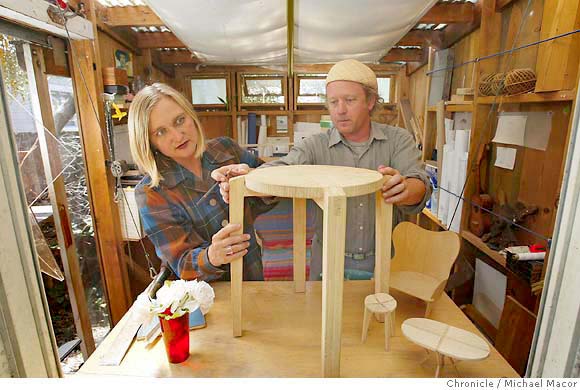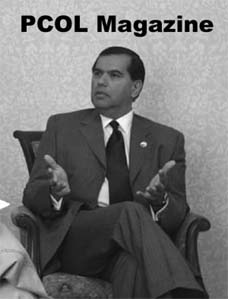
Togo RPCVs Scott Constable and Ene Osteraas-Constable are furniture designers at Wowhaus
More Is More
When did furniture become so complicated?
Kristin Palm
Sunday, September 5, 2004
One important thing to know about Wowhaus -- the husband-and-wife- design team of Scott Constable and Ene Osteraas-Constable -- is that there really is a Wow House.
When the couple's young daughter first ventured inside the narrow, open- air shed her father had erected in the backyard, all she could say, over and over again, was "Wow." Soon, this secluded garden studio where Scott draws architectural renderings and constructs models came to be known as the Wow House, not only to the Constable family but also to their friends, who began to identify all small, stand-alone spaces by this name. So in 1999, when Ene and Scott decided to formalize their already burgeoning design business, Wowhaus logically became the couple's commercial identity.
The Oakland studio functions more like a collective (albeit a tiny one) than a corporation, with plans and projects evolving continually. Furniture design is the backbone of the company, but the couple has embarked on several large-scale endeavors of both the orthodox (a Napa restaurant interior) and esoteric (a roving radio station) variety. Even their home designs lean toward the surreal. One of the pair's signature projects is the Treenest, a rough- hewn variation on the traditional childhood haunt designed for young and old alike.
While Scott says he feels an affinity with the sleek, utilitarian products of the Bauhaus, his company's play on words is also meant to underscore the differences between the Wowhaus approach and that of its early 20th century forebears.
"We might have a similar goal of saying, 'OK, how can this design improve people's lives?' But I think it's learning from the fallacies of that, too," he observes. "It's not nostalgic or sentimental, but it doesn't abandon the past, and I think the Bauhaus was pretty aggressive about abandoning the past. "
Wowhaus, on the other hand, embraces the past in a most exuberant manner. Clients are always educated on the history of the materials used and reasons for the processes chosen. What's more, a Wowhaus product is expected to acquire a history of its own.
Take the Constable's own dining room table. A sleek, Scandinavian- influenced design built to disassemble with the removal of a single pin, its soft yellow cedar quite purposely exhibits the wear and tear of daily use. If one looks closely, marks from years of handwritten notes, homework and drawings can be seen embedded into its surface, small dings and scrapes from countless meals shared dot its length. What a typical design firm would see as a flaw, Wowhaus celebrates as an asset. That table is a living record of a family's communion. Each small blemish only increases its value.
"I learn a lot from looking at old things, and even new things, but I'm more interested in how they've worn or how they've been discarded or how they've gotten valuable," Scott says. "A good analogy maybe is something like an heirloom, something that's inherited. It's a condition. In order to have that, you need to have this transference of value between generations."
The woodshop is primarily Scott's domain, while Ene has been focusing on a series of organic gardening ventures, but the couple agrees that every Wowhaus project is a joint one. In addition to providing post-construction assistance (sanding is her specialty, Ene says), Ene serves as a "reality check" for his furniture designs, explains Scott. The big-concept projects -- the radio station, a neighborhood revitalization plan -- are collaboratively developed. The fact that Scott and Ene are partners in both business and life make for an unusually forthright working relationship.
"One of the things we've realized working together is that we can be brutal with each other and it's great," Ene says. "We're incredibly efficient because there is no ego."
Scott and Ene met in upstate New York in 1988. At the time, Ene was producing the Greenwich Village Halloween Parade and Scott was apprenticing with master woodworkers, building individually crafted homes from regionally grown lumber. Ene had recently graduated from the University of Massachusetts, which she had entered as a studio art major but, unable to function in the isolation of the studio, graduated with a liberal arts degree. Scott, had left the architecture program at the Rhode Island School of Design and completed his degree in sculpture at the Art Institute of Chicago.
Before settling in Oakland, they served in the Peace Corps in West Africa for two years. Upon returning to the United States, they drove across country, and eventually made it to Alaska, where they worked on a salmon seiner. From there, they headed south to visit friends on the West Coast and, spending time in the Bay Area, discovered they had a deep affinity with Oakland. San Francisco, Berkeley and Silicon Valley all appeared to have established identities, Ene observes, while Oakland seemed more like a story in the making.
"We felt more comfortable here right off the bat, and that's something that's hard to peg exactly, but there was a sense of possibility, and there still is," she says.
Scott and Ene each trace their style-with-substance approach to childhood. Scott says he was influenced by his grandfathers, both engineers and amateur cabinetmakers, as well as by stories he heard about his great-grandfather, a zeppelin designer. Ene attributes her interest in narratives -- thus the emphasis on each of their product's back story -- to time spent living in West Africa both with her parents, who were oral historians, and in the Peace Corps. There, she says, she also became better attuned to the symbiosis between life and art.
"I haven't looked into it, but I feel like I'm in a long lineage of craftspeople of a certain kind of stripe," Scott says. Ene, often quick to expound on her husband's humble assessments, notes that Scott is descended from British Romantic landscape painter John Constable. Scott, in turn, theorizes that his wife's interest in stories is likely derived from her great- grandfather, a national playwright of Estonia.
Like the dining room table, Wowhaus' furniture is typically designed to function in multiple scenarios, preferably those that bring people together. "I think what we're after is eliminating the boundaries between design, production, merchandizing, consumption, so everybody is a collaborator in a way, and wherever the exchange is, there's high value." This aim is so central to Wowhaus' mission that Scott has begun designing the tools used to make the furniture.
Even Wowhaus' more conceptual pieces still function so that the design is never solely a critique of contemporary culture, but also a vehicle for making said culture just a little more simple or enjoyable. Scott's portable, all- weather Field Desk, for instance, part of the Bay Area Furniture Art exhibition at San Francisco's Blue Room Gallery last fall, might be seen in the context of the event as a critique of the ever-pervasive nature of work. The Constables, on the other hand, see the piece as a humorous but functional tool they can bring with them off-site.
Likewise, while a Wowhaus-designed tree house appears in Cazenovia, New York's Stone Quarry Sculpture Park, offering commentary on shifting perceptions of nature and community, others have been erected for everyday use in private backyards. Of course, the sculpture is not much different than the Treenests found at homes in Petaluma and Beach Lake, Penn. The cocoonlike collections of branches and bark are derived from local wood, none of which penetrates the actual tree. The communal assembly process is an inherent component of the design.
"They were kind of an extension of hanging out, of saying people are at their best when they're working together on a simple task collectively, not unlike any kind of improvised thing: a barbecue, a volleyball game, a walk," Scott says. "It's like, we have a long weekend, we get a bunch of people together, we have food and we all make the tree house. There's no skill involved, there's no mastery involved; everyone's kind of equal."
"It's actually quite complex," Ene says.
"But the tools are really simple," Scott clarifies.
"And," concludes Ene, "everyone can participate."
Scott is working on additional Field Objects -- he has fashioned a weather-resistant banjo from wood, aluminum and glass to accompany the Treenests, for instance -- as well as seeking markets for his elegantly stripped-down stools and chairs based on traditional West African furniture. (Not one to get overly formal about his designs, Scott named one of these pieces -- a low-to-the-ground, highly angular rocker that resembles a stealth bomber as much as a tribal artifact -- Crotch Rocket.) He's also seeking ways to build with hard-to-manipulate, but abundant and locally available, woods such as eucalyptus.
Following in the footsteps of her parents, Ene has become ensconced not just in the mechanics of, but the stories behind community gardening. In addition to developing an Edible Schoolyard with Alice Waters of Chez Panise (Wowhaus eventually designed the accompanying kitchen and is now working on the dining room, all housed at a public middle school), she has recently begun collecting oral histories of Mien immigrants who grow native plants at Peralta Hacienda Historical Park in Oakland.
But lest they begin to take themselves too seriously, the Constables spent last spring indulging their whimsical side. In April, they towed a gleaming, aluminum-sided, solar-powered micro-radio station down San Francisco's Market Street, broadcasting interviews the pair had conducted with various mainstays of the strip. Although the project was spurred by a very sincere investigation into such matters as dialogue and surveillance, nobody, least of all the Constables -- who now house this hard-to-miss, alien- looking structure in their driveway -- could deny the hilarity of the project's execution. And that, too, is part of the point, Scott insists.
"I see work in general as being comic instead of tragic. So we can never get too serious," he explains. Asked to elaborate, he's momentarily stumped.
"It's not exactly slapstick," he continues thoughtfully. "It tends to lighten people. We do these things that can be really rigorous, really kind of sophisticated, but ultimately they're about making people feel more comfortable and more themselves and a little more effervescent, whether it's a space or an object or a situation, like a good comedy does or ..."
"... a good glass of champagne, a good meal," Ene jumps in. "You should feel this way," she continues. "We should all feel this way more!"
Kristin Palm has written about urban planning, architecture and design for Metropolis, Planning and ReadyMade. She lives in San Francisco.

